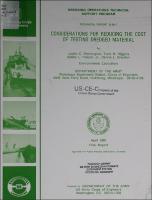Please use this identifier to cite or link to this item:
https://hdl.handle.net/11681/4636Full metadata record
| DC Field | Value | Language |
|---|---|---|
| dc.contributor.author | Pennington, Judith C. | en_US |
| dc.contributor.author | Higgins, Todd R. | en_US |
| dc.contributor.author | Folsom, Bobby L. | en_US |
| dc.contributor.author | Brandon, Dennis L. | en_US |
| dc.creator | Dredging Operations Technical Support Program (U.S.) | en_US |
| dc.creator | Environmental Laboratory (U.S.) | en_US |
| dc.date.accessioned | 2016-03-16T22:17:50Z | en_US |
| dc.date.available | 2016-03-16T22:17:50Z | en_US |
| dc.date.issued | 1990-04 | en_US |
| dc.identifier.govdoc | Technical Report D-90-7 | en_US |
| dc.identifier.uri | http://hdl.handle.net/11681/4636 | en_US |
| dc.description | Technical Report | en_US |
| dc.description.abstract | The high cost of chemical analyses and bioassays of dredged material makes it necessary for decision makers to limit testing to that which will sufficiently characterize the sediment to evaluate a selected disposal alternative. This report offers guidance for limiting the amount of testing necessary and considers other factors that could potentially reduce the cost of testing dredged material. The importance of an initial site evaluation to reduce the extent of dredged material testing is stressed. Unless a reason to believe that contamination exists can be established through examination of historical data and other site characteristics, no testing is warranted. The need for testing can sometimes be eliminated by examination of regulatory criteria for categorical exclusions, i.e. circumstances under which no testing is required. Additional cost savings can sometimes be generated during the scoping process by amelioration of the concerns of interested parties prior to preparation of an environmental impact statement. Tiered testing as presented in the Federal Standard is recommended as a cost-reduction approach to material evaluation. The principal advantage of tiered testing is that it can be stopped when sufficient information has been acquired to make a decision regarding the suitability of a given disposal alternative. In developing a sampling plan, consideration should be given to stratified random sampling, compositing, archiving, and use of a risk factor when determining the number of samples needed. All of these considerations, when applied under appropriate circumstances, can result in cost savings. Two factors that could potentially reduce the cost of chemical analysis are careful contract laboratory selection and the use of screening tests and representative analytes. Cost reduction can be achieved in testing dredged material to determine the suitability of a selected disposal alternative by carefully considering the options. The greatest cost reduction will result from the exercise of informed judgment concerning such factors as the significance of site history, the precision and resolution of the sampling design, and the acceptable degree of risk that the sampling will miss contaminated areas. | en_US |
| dc.description.sponsorship | Dredging Operations Technical Support Program (U.S.) | en_US |
| dc.description.sponsorship | United States. Army. Corps of Engineers | en_US |
| dc.description.tableofcontents | Preface...............................1 Part I: Introduction...............................3 Background...............................3 Objective...............................3 Part II: Initial Evaluation...............................4 Establishing a Reason to Believe that Contamination Exists...............................4 Categorical Exclusions...............................5 Site Histories...............................6 The Scoping Process...............................6 Part III: Tiered Testing...............................8 Part IV: Sampling and Sample Analyses...............................10 Sampling Plan Approaches...............................10 Chemical Analyses...............................13 Bioassays...............................17 Part V: Summary and Conclusions...............................19 Summary...............................19 Conclusions...............................19 References...............................21 | en_US |
| dc.format.extent | 25 pages/4.42 MB | en_US |
| dc.format.medium | en_US | |
| dc.language.iso | en_US | en_US |
| dc.publisher | U.S. Army Engineer Waterways Experiment Station | en_US |
| dc.relation | http://acwc.sdp.sirsi.net/client/en_US/search/asset/1036381 | en_US |
| dc.relation.ispartofseries | Technical Report (Dredging Operations Technical Support Program (U.S.)) ; no.Technical Report D-90-7 | en_US |
| dc.rights | Approved for public release; distribution is unlimited | en_US |
| dc.source | This Digital Resource was created from scans of the Print Resource | en_US |
| dc.subject | Archiving | en_US |
| dc.subject | Containment | en_US |
| dc.subject | Tiered testing | en_US |
| dc.subject | Bioassays | en_US |
| dc.subject | Regulatory criteria | en_US |
| dc.subject | Compositing | en_US |
| dc.subject | Screen testing | en_US |
| dc.subject | Water quality | en_US |
| dc.subject | Dredging spoil | en_US |
| dc.subject | Dredging Operations Technical Support Program (U.S.) | en_US |
| dc.title | Considerations for reducing the cost of testing dredged material | en_US |
| dc.type | Report | en_US |
| Appears in Collections: | Technical Report | |
Files in This Item:
| File | Description | Size | Format | |
|---|---|---|---|---|
| TR-D-90-7.pdf | Technical Report D-90-7 | 4.42 MB | Adobe PDF |  View/Open |